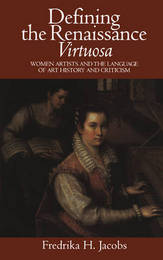
|
Defining the Renaissance 'Virtuosa': Women Artists and the Language of Art History and Criticism
Hardback
Main Details
| Title |
Defining the Renaissance 'Virtuosa': Women Artists and the Language of Art History and Criticism
|
| Authors and Contributors |
By (author) Fredrika H. Jacobs
|
| Physical Properties |
| Format:Hardback | | Pages:254 | | Dimensions(mm): Height 231,Width 157 |
|
| Category/Genre | Renaissance art |
|---|
| ISBN/Barcode |
9780521572705
|
| Classifications | Dewey:709.024 |
|---|
| Audience | | Tertiary Education (US: College) | | Professional & Vocational | |
|---|
| Illustrations |
32 Halftones, unspecified
|
|
Publishing Details |
| Publisher |
Cambridge University Press
|
| Imprint |
Cambridge University Press
|
| Publication Date |
13 August 1997 |
| Publication Country |
United Kingdom
|
Description
Defining the Renaissance "Virtuosa" considers the language of art in relationship to the issues of gender difference through an examination of art criticism written between 1550 and 1800 on approximately forty women artists who were active in Renaissance Italy. Fredrika Jacobs demonstrates how these theoretical writings defined women artists, by linking artistic creation and biological procreation. Jacobs' study shows how deeply the biases of these early critics have inflected both subsequent reception of these Renaissance virtuose, as well as modern scholarship.
Reviews"The book is more than a contribution to feminist revisionism; it also adds much to our understanding of how the art of painting was understood, and by defining 'feminine' artists and painting, it also gives a clearer sense of how 'masculinized' the concept of creativity was in the Renaissance." A. Langdale, Choice "Thanks to the breadth of her textual analyses and the insightful questions she poses throughout, Jacobs offers a richly illuminating reading of the construction of the Renaissance woman artist. In turn, the book provides a welcome context for several worthy but more narrowly focused critical studies on related subjects whose contents she integrates into her own narrative...a considerable achievement in having uncovered and woven together a complex of ideas that expands consequentially our view of artistic activity in Early Modern Italy." Leslie Korrick, Sixteenth Century Jrnl
|